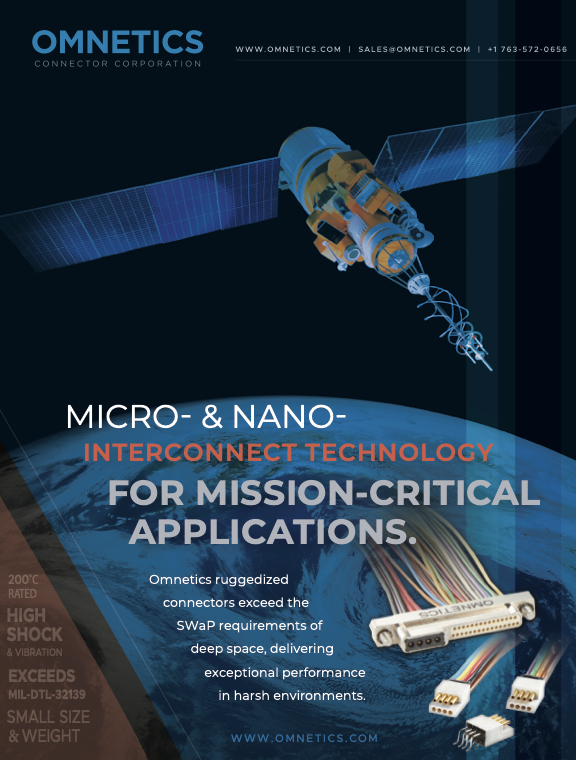Orbit unveils OrBeam MIL—next-generation ESA

Orbit Communication Systems Ltd. is unveiling the company’s new OrBeam MIL Electronically Steerable Antenna (ESA) at Satellite DC 2025. This cutting-edge phased array antenna is designed to meet the growing demand for continuous, reliable satellite communications across LEO, MEO, and GEO orbits.
With the rapid increase in satellite constellations and the evolving needs of defense, commercial, and enterprise users, Orbit’s OrBeam MIL ESA delivers an agile, multi-orbit solution that requires no user intervention. The system’s electronically controlled beam steering allows seamless connectivity with multiple satellites, enhancing operational efficiency and uninterrupted communication across the most challenging environments.
 The new antenna supports Ka- or Ku -frequencies and is designed for seamless connectivity with GEO, MEO, and LEO satellites. Its flat- panel design with no moving parts ensures lower power consumption and high reliability, while its compact and lightweight structure enables fast deployment across aerial, maritime, and land-based platforms.
The new antenna supports Ka- or Ku -frequencies and is designed for seamless connectivity with GEO, MEO, and LEO satellites. Its flat- panel design with no moving parts ensures lower power consumption and high reliability, while its compact and lightweight structure enables fast deployment across aerial, maritime, and land-based platforms.
The system is capable of Make-Before-Break (MBB) satellite handovers, providing solutions for high-speed, uninterrupted low- latency satellite communications.
“As the satellite communication landscape evolves at an unprecedented pace, Orbit continues to push the boundaries of innovation,” said Daniel Eshchar, CEO of Orbit. “Our new OrBeam MIL ESA system represents a breakthrough in multi- orbit connectivity, providing defense and commercial customers with a highly reliable, low power consumption, and future-ready SATCOM solutions.”
About Orbit Communication Systems:
Orbit Communication Systems, a global leader in airborne and maritime communications, satellite tracking, and ground-station technology, revolutionizes global connectivity with cutting-edge solutions for the new space era. Our state-of-the-art systems are utilized on a wide range of platforms, including mission aircraft, trainers, rotary-wing aircraft, transport vessels, tankers, jet fighters and unmanned platforms. Our reach extends to naval vessels, armored land platforms, cruise ships, ground stations, and offshore platforms, ensuring comprehensive coverage across maritime and terrestrial domains. Orbit provides innovative, cost-effective, and reliable solutions to commercial operators, major air forces, navies, space agencies, and emerging New Space companies. Orbit is publicly traded on the Tel Aviv Stock Exchange and is under the control of the FIMI Investment Fund. The company maintains a subsidiary in Florida, USA, which provides production, integration, and support capabilities for the North American market. Its global operations, encompassing, marketing, sales, and customer service, extend across Europe, and the Far East.
GA-ASI welcomes USAF designation for new Collaborative Combat Aircraft—YFQ-42A
General Atomics Aeronautical Systems, Inc. (GA-ASI) welcomes the U.S. Air Force’s designation for its Collaborative Combat Aircraft: the new uncrewed jet fighter will be called the YFQ-42A—this announcement followed an earlier USAF decision in 2024 that GA-ASI was selected to develop and build the YFQ-42A.

The U.S. Air Force selected YFQ-42A as the Mission Design Series (MDS) for GA-ASI’s CCA prototype, representing the first in a new generation of unmanned fighter aircraft. YFQ-42A will be critical in securing air dominance for the Joint Force in future conflicts, leveraging autonomous capabilities and crewed-uncrewed teaming to defeat enemy threats in contested environments.
The U.S. Air Force is developing Autonomous Collaborative Platforms to maintain its air superiority. Semi-autonomous aircraft, such as the YFQ-42A, will enhance flexibility, affordability, and mission effectiveness. YFQ-42A will enhance air superiority as a flexible, affordable force multiplier. It is designed to integrate seamlessly with current and next-generation crewed aircraft, expanding mission capabilities and ensuring continued air dominance. In short, YFQ-42A provides fighter capacity – affordable mass—at a lower cost and on a threat-relevant timeline.
The YFQ-42A designation follows the U.S. Air Force’s decision to designate GA-ASI’s highly common predecessor aircraft as the XQ-67A Off-Board Sensing Station. The XQ-67A was ordered by the Air Force Research Lab to support the development of concepts necessary to implement the vision for CCA.
In the U.S. Air Force system, an “X” plane is designed for testing and experimentation, while “Y” describes initial production-representative aircraft, usually ahead of a formal program. “F” is for fighter and “Q” designates an uncrewed aircraft. Once the production-representative aircraft moves into production, the “Y” will drop from the prefix.
“We’re proud to get a new official aircraft designation,” said GA- ASI President David R. Alexander. “YFQ-42A continues a long and distinguished history for GA-ASI that dates back to the 1990s and the debut of the RQ-1 Predator®, which later changed to MQ-1 Predator. These aircraft represent an unrivaled history of capable, dependable uncrewed platforms that meet the needs of America’s warfighters and point the way to a significant new era for airpower.”
Curtiss-Wright receives $18 million follow-on order from USMC for tactical comms
Curtiss-Wright’s Defense Solutions Division has received a follow-on order from the U.S. Marine Corps, PEO Land Systems, via Defense Logistics Agency – Tailored Logistic Support (DLA-TLS) contract, to provide the Modular Open Systems Approach (MOSA) based, tactical communications technology for use in the Application Server Module (ASM), part of the Combat Data Network (CDN) program.

Under the contract, Curtiss-Wright will supply PEO Land Systems with its size, weight and power (SWaP) optimized PacStar® 400-Series technology, including the PacStar 451 Server, PacStar 453 GPU Enhanced Server, and PacStar 448 10-port 10 GbE Switch modules.
These products provide small form factor (SFF) ruggedized compute and switching capability at the tactical edge, significantly improving mobility and enhancing speed of deployment while improving transmission rates and data access. The contract is valued at approximately $18 million.
“Curtiss-Wright is proud to have received this follow-on contract from the U.S. Marine Corps to provide our industry-leading, cost-effective tactical edge communications hardware in support of the Combat Data Network,” said Brian Perry, Senior Vice President and General Manager, Curtiss-Wright Defense Solutions Division. “This win builds upon our earlier selection as a critical supplier for the CDN program, including WAN Services Module – Light (WSM-L) in 2020, User Access Case (UAC) in 2021, and WAN Services Module – Expeditionary (WSM-X) in 2022.”
WISeKey recruits space experts to enhance WISeSat collaboration with Swiss Armed Forces
WISeKey International Holding (NASDAQ: WKEY; SIX: WIHN) with its subsidiaries WISeSat.Space and SEALSQ Corp. (NASDAQ: LAES) (“SEALSQ”) has added several key space experts to the company’s team—this expansion will further strengthen the company’s capabilities in space operations and regulatory compliance, and enhancing its collaboration with the Swiss Armed Forces.

New team members include…
» Edward Burger, Space Regulatory Operations Specialist. Mr.Burger brings extensive experience in navigating the complex landscape of telecommunications law and regulation for space operations, ensuring projects comply with national and international requirements.
» Yiorgos Lemos, Space Operations Specialist. Mr. Lemos’ knowledge in operational processes and satellite technology will enhance WISeKey’s operational efficiency and effectiveness in mission execution.
» Eric Bottlaender, Space Technology Monitoring Specialist. Mr. Bottlaender will focus on monitoring emerging technologies and trends in the space sector, enablingWISeKeytoremain at the forefront of innovation.
» Philip Haemelink, Space Project Manager & Software Engineer. Mr.Haemelink brings valuable experience fromthe space sector and will oversee project coordination between WiseSat and clients while leading software integration efforts.
» Vlad Dancau, Space Software Engineer. Mr. Dancau bringsdeep expertise in applied cryptography, network security, andtelecommunications, empowering WISeKey to advance securesatellite communications.
“We are thrilled to have these talented professionals join our team,” said Carlos Moreira, CEO and Founder at WISeKey. “Their expertise will not only enhance our capabilities but also strengthen our partnership with the Swiss Armed Forces as we work toward innovative solutions in the space industry. With the addition of this expert team, WISeKEY is poised to take on new challenges and opportunities in collaboration with the firm’s esteemed partners.”

